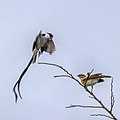| Pin-tailed whydah | |
|---|---|
 | |
| Male in breeding plumage São Tomé and Príncipe | |
| Scientific classification | |
| Kingdom: | Animalia |
| Phylum: | Chordata |
| Class: | Aves |
| Order: | Passeriformes |
| Family: | Viduidae |
| Genus: | Vidua |
| Species: | V. macroura |
| Binomial name | |
| Vidua macroura (Pallas, 1764) | |
| Synonyms | |
| |
The pin-tailed whydah (Vidua macroura) is a small songbird with a conspicuous pennant-like tail in breeding males. It is a resident breeding bird in most of Africa south of the Sahara Desert.






